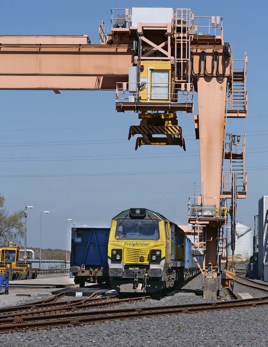Cutting traction emissions
Until a traffic flow can be electric-hauled, a significant technical measure taken by freight operating companies to reduce carbon is experiments with fuels as a substitute for red diesel.
The most high-profile tests have been DB Cargo’s trials at Toton with 100% renewable Hydro-treated Vegetable Oil (HVO). These have proved so successful that the company has already committed to its use in a new traffic flow.
Carbon reductions of up to 90% are claimed for the Class 66s undergoing trials in traffic, before the start of a new return-loaded automotive service conveying Toyota cars between Toton, France and the Czech Republic. Subject to planning approval, the thrice-weekly service will begin in January.
The potential savings from use of the biodegradable fuel are significant. DB Cargo currently uses 45 million litres of red diesel a year, whereas HVO is derived from 100% waste products and no virgin products are used in its manufacture.
Among the DfT’s ‘First of a Kind’ grants for ideas to create a lower-emission and greener railway was Freightliner’s experiments using a mix of diesel, hydrogen and biogas with precision injection technology. The exhaust emissions from the Leeds-based Class 66 are being assessed by RSSB. And if successful, the results will be on the open market, as ‘First of a Kind’ ideas will not become intellectual property.
StopStart technology is now common, and according to Voith can save 11,000 litres of fuel per locomotive a year, based on reducing idling time by 720 hours per year.
Of course, the best solution to idling is to minimise the time spent in loops to allow faster trains to overtake. This is one facet of a modelling system called NR+, which has been created by the University of Hull’s Logistics Institute (another beneficiary of a ‘First of a Kind’ grant).
Holding such data as the gradient profile of every NR route, loading gauge, weight restrictions, route availability and even engineering possessions, NR+ calculates the carbon emissions of freight trips by different routes. It saves time and increases the efficiency of train pathing.
Another way to reduce idling is to explore the scope for thinning passenger frequencies at times of low demand, if it would create a robust freight path.
Transport Scotland Director of Rail Bill Reeve suggests: “One of the best things we as the franchising authority can do is to agree to amend a passenger specification to facilitate new freight business. If it’s a well-used peak-hour passenger train we wouldn’t do it, but if a lightly loaded train makes way for 40 to 50 containers, it’s a no-brainer.”
This would require the DfT (in England and Wales) to de-specify the services, but it’s obvious that it will be some years before passenger numbers return to pre-COVID levels.
And the benefits are not just reduced idling times or avoiding the energy use in restarting a train of anything up to 4,000 tonnes. Non-stop running also improves the circulation of locomotives and wagons and reduces driver diagrams, lowering unit cost and helping modal shift.
Richard Moody, NR’s Head of Strategic Planning (Freight & Network Strategy), acknowledges the politics behind the idea, since containers don’t vote.
However, he adds: “We found that on the top ten axes, the scope for freight substitution was 30 circulations a day. It’s a modest number, but it would reduce carbon emissions by about 150,000 tonnes pa, which has captured the DfT’s attention.”
In a study by Deloitte for the Rail Delivery Group, examining the role and value of rail freight, the benefits offered by different services was compared. In one example, an intermodal service generated benefits of £1.3 million pa against off-peak passenger train benefits of £170,000.











